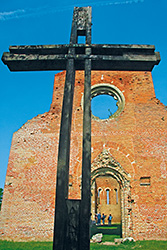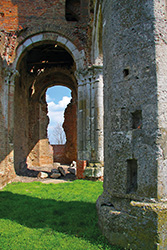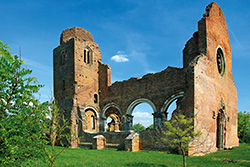Pilgrimages
ARAČA, AN UNUSUAL CHURCH LOST IN THE PLANE
Silent Witness of the Past
Halfway from Novi Bečej to Novo Miloševo, it will appear in the distance, on the boundary of heavens and earth, as a mirage. The Romanesque church was built on the foundations of an older temple. The oldest preserved written document mentioning it is from the XIII century, when it had the status of a Benedictine abbey. It was renewed upon the order of Elisabeth of Anjou, was the possession of Serbian despots, destroyed by the Cumans and Ottomans, time and storms, but it still stands. Fast and shallow, do we understand what its selvages are telling us?
Text and photo: Josip Šarić
 There are places, people and things which are best concealed when not hidden at all. We will not go into the reasons for concealing, but the truth that something is harder to see when exposed to sight seems to be valid for Arača as well. Bare and completely exposed to the strikes of strong winds of the plane, this church has been resisting time, nature and people for centuries. There are places, people and things which are best concealed when not hidden at all. We will not go into the reasons for concealing, but the truth that something is harder to see when exposed to sight seems to be valid for Arača as well. Bare and completely exposed to the strikes of strong winds of the plane, this church has been resisting time, nature and people for centuries.
 Marginalized in space and time, so much that you cannot reach it even by accident. Those who want to see it must carefully look towards the boundary of heavens and earth, where Arača appears as a mirage. When traveling from Belgrade to the north, after Zrenjanin and Novi Bečej, halfway to Novo Miloševo, there was until recently a small, desolated railway house on the right side of the road, as a weak sign where one should get off the asphalt road, a house that forgot its youth a long time ago. Today it is gone as well, as if, with its departure, it also joined the magic that hides Arača. A field road leads from there, recently covered with gravel. One can, therefore, reach it by car, without getting stuck. Dr Marginalized in space and time, so much that you cannot reach it even by accident. Those who want to see it must carefully look towards the boundary of heavens and earth, where Arača appears as a mirage. When traveling from Belgrade to the north, after Zrenjanin and Novi Bečej, halfway to Novo Miloševo, there was until recently a small, desolated railway house on the right side of the road, as a weak sign where one should get off the asphalt road, a house that forgot its youth a long time ago. Today it is gone as well, as if, with its departure, it also joined the magic that hides Arača. A field road leads from there, recently covered with gravel. One can, therefore, reach it by car, without getting stuck. Dr iving a car, however, although practical, is not romantic at all. Such an approach destroys the magic of awaiting the contours of the church that slowly appears in the horizon. A traveler with a motor vehicle also misses the buzz of myriads of insects during warm spring days, or the chirping of birds in low bushes along the road, or the scent of wild flowers spreading over the plain. He also won’t see numerous rabbits, real flocks of deer, making the traveler feel as if lost in Serengeti savannah. iving a car, however, although practical, is not romantic at all. Such an approach destroys the magic of awaiting the contours of the church that slowly appears in the horizon. A traveler with a motor vehicle also misses the buzz of myriads of insects during warm spring days, or the chirping of birds in low bushes along the road, or the scent of wild flowers spreading over the plain. He also won’t see numerous rabbits, real flocks of deer, making the traveler feel as if lost in Serengeti savannah.
In the place the locals call Sedmiter, because roads to seven Banat villages start from there, the church finally shows itself in its full beauty, which is not decreased by destroyed parts of the dome, walls and bell tower. Looking at the edifice, still grandiose, there is an inevitable question of its age and fate following it.
FROM THE CUMANS TO A WINTER STORM
 It is not known for certain who built Arača as a Romanesque church and when. Archeological probes showed that it was built on the foundations of an older sacral edifice. Testifying about it is a pre-Romanesque relief tombstone, which probably belonged to the original church. The tombstone is now kept in the National Museum in Budapest and is one of the few witnesses of the turbulent past of Arača. It is not known for certain who built Arača as a Romanesque church and when. Archeological probes showed that it was built on the foundations of an older sacral edifice. Testifying about it is a pre-Romanesque relief tombstone, which probably belonged to the original church. The tombstone is now kept in the National Museum in Budapest and is one of the few witnesses of the turbulent past of Arača.
This church was mentioned for the first time in written documents in the XIII century, when it had the status of a Benedictine abbey. The first destructions followed in 1280, when it became the loot of the Cuman steppe tribe. It was renewed in 1370, upon the order of Elisabeth of Anjou and the Gothic bell tower most probably belongs to tha t period. According to preserved written documents, Arača came into possession of Despot Stefan Lazarević in 1417 and of Despot Đurađ Branković in 1441. t period. According to preserved written documents, Arača came into possession of Despot Stefan Lazarević in 1417 and of Despot Đurađ Branković in 1441.
A settlement was formed around the church, mentioned in written documents as a town in 1422. Today, there is not a single trace of the town, consisting of humble houses made of plaiting. In the eve of Ottoman conquests, Arača was inhabite d by Serbs. The adaptation in 1551 made Arača a fortification, but that same year, without any fight, it was handed to the Ottomans. After the surrender, the church itself was burned down. That is when its historical end actually begins, because after that destruction, it has never been renewed. Besides, the settlement with Serbian population survived until 1720, when it was abandoned because of the Ottoman oppression and unbearable taxes. Unfortunately, it was not the end of destruction and strikes. The locals also took away processed stone and bricks. Then came treasure hunters who left holes in the area around the church, visible even today. The final strike was given by nature, as if it also turned against the suffering edifice. Chronicle writers noted that a strong winter storm, characteristic for the Banat plane, destroyed parts of the already damaged walls and top of the gothic bell tower on December 13, 1863. d by Serbs. The adaptation in 1551 made Arača a fortification, but that same year, without any fight, it was handed to the Ottomans. After the surrender, the church itself was burned down. That is when its historical end actually begins, because after that destruction, it has never been renewed. Besides, the settlement with Serbian population survived until 1720, when it was abandoned because of the Ottoman oppression and unbearable taxes. Unfortunately, it was not the end of destruction and strikes. The locals also took away processed stone and bricks. Then came treasure hunters who left holes in the area around the church, visible even today. The final strike was given by nature, as if it also turned against the suffering edifice. Chronicle writers noted that a strong winter storm, characteristic for the Banat plane, destroyed parts of the already damaged walls and top of the gothic bell tower on December 13, 1863.
AMAZING STABILITY
 As much as it may seem romantic and inspiring, it is impossible to talk about Arača, without mentioning sometimes boring historical data. Standing in the shadow of the edifice, a traveler must bear in mind that the church was burned and destroyed several times, tha As much as it may seem romantic and inspiring, it is impossible to talk about Arača, without mentioning sometimes boring historical data. Standing in the shadow of the edifice, a traveler must bear in mind that the church was burned and destroyed several times, tha t it was plundered by the Cumans and the Ottomans, that it served sometimes to the Catholics and sometimes to Orthodox Christians as a spiritual center in times of peace, that it was altered at times of war into a defensive fortress. In spite of all that, Arača still stands unbreakable, provoking amazement with its stability, simple beauty and elegance fitting into its bare surrounding. t it was plundered by the Cumans and the Ottomans, that it served sometimes to the Catholics and sometimes to Orthodox Christians as a spiritual center in times of peace, that it was altered at times of war into a defensive fortress. In spite of all that, Arača still stands unbreakable, provoking amazement with its stability, simple beauty and elegance fitting into its bare surrounding.
If the traveler, after walking away from Arača, returning to his modern everyday life, succeeded in feeling Arača as a living witness of the past times, rather than as a sleeping and silent cultural and historical monument, his journey has fulfilled its purpose and the first visit to this fairytale-like edifice will probably not be the last. At least that’s how it was with me.
***
Elevated
Although it cannot be noticed, the area where the church was raised is actually slightly elevated at an altitude of 82 meters. It used to be surrounded with the waters of the Mali Begej, Crna Bara and Veliko Kopovo, Pošta Kopovo and Bikoš swamps. Protected from flooding and connected to the surrounding both with land and water routes, the area was convenient for inhabiting. Its advantages were noticed in prehistoric times, so traces of the Starčevo culture from the older Neolithic can be found in the immediate vicinity.
***
Stopped Dilapidation
Arača has been protected by the law as a cultural good since 1948. Conservation works, which stopped it from dilapidating, lasted from 1970 to 1978.
|
